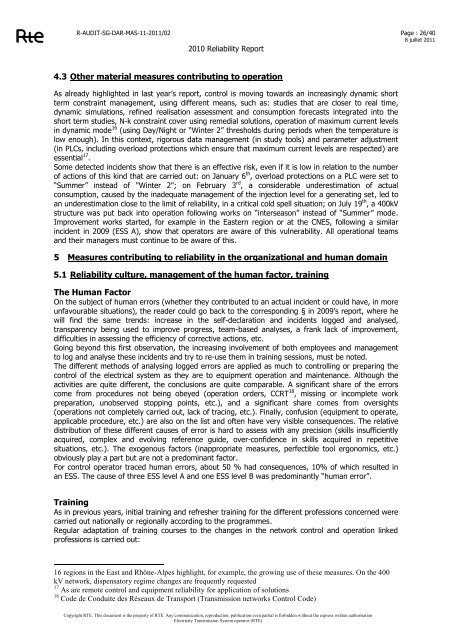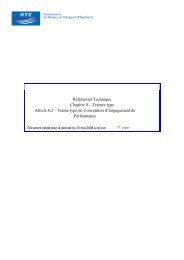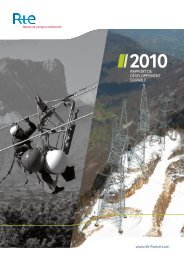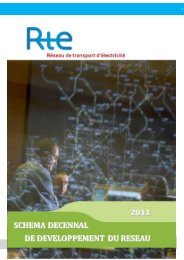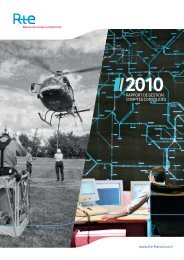Power System Reliability Report - RTE
Power System Reliability Report - RTE
Power System Reliability Report - RTE
- No tags were found...
You also want an ePaper? Increase the reach of your titles
YUMPU automatically turns print PDFs into web optimized ePapers that Google loves.
R-AUDIT-SG-DAR-MAS-11-2011/022010 <strong>Reliability</strong> <strong>Report</strong>Page : 26/408 juillet 20114.3 Other material measures contributing to operationAs already highlighted in last year‟s report, control is moving towards an increasingly dynamic shortterm constraint management, using different means, such as: studies that are closer to real time,dynamic simulations, refined realisation assessment and consumption forecasts integrated into theshort term studies, N-k constraint cover using remedial solutions, operation of maximum current levelsin dynamic mode 16 (using Day/Night or “Winter 2” thresholds during periods when the temperature islow enough). In this context, rigorous data management (in study tools) and parameter adjustment(in PLCs, including overload protections which ensure that maximum current levels are respected) areessential 17 .Some detected incidents show that there is an effective risk, even if it is low in relation to the numberof actions of this kind that are carried out: on January 6 th , overload protections on a PLC were set to“Summer” instead of "Winter 2"; on February 3 rd , a considerable underestimation of actualconsumption, caused by the inadequate management of the injection level for a generating set, led toan underestimation close to the limit of reliability, in a critical cold spell situation; on July 19 th , a 400kVstructure was put back into operation following works on “interseason” instead of “Summer” mode.Improvement works started, for example in the Eastern region or at the CNES, following a similarincident in 2009 (ESS A), show that operators are aware of this vulnerability. All operational teamsand their managers must continue to be aware of this.5 Measures contributing to reliability in the organizational and human domain5.1 <strong>Reliability</strong> culture, management of the human factor, trainingThe Human FactorOn the subject of human errors (whether they contributed to an actual incident or could have, in moreunfavourable situations), the reader could go back to the corresponding § in 2009‟s report, where hewill find the same trends: increase in the self-declaration and incidents logged and analysed,transparency being used to improve progress, team-based analyses, a frank lack of improvement,difficulties in assessing the efficiency of corrective actions, etc.Going beyond this first observation, the increasing involvement of both employees and managementto log and analyse these incidents and try to re-use them in training sessions, must be noted.The different methods of analysing logged errors are applied as much to controlling or preparing thecontrol of the electrical system as they are to equipment operation and maintenance. Although theactivities are quite different, the conclusions are quite comparable. A significant share of the errorscome from procedures not being obeyed (operation orders, CCRT 18 , missing or incomplete workpreparation, unobserved stopping points, etc.), and a significant share comes from oversights(operations not completely carried out, lack of tracing, etc.). Finally, confusion (equipment to operate,applicable procedure, etc.) are also on the list and often have very visible consequences. The relativedistribution of these different causes of error is hard to assess with any precision (skills insufficientlyacquired, complex and evolving reference guide, over-confidence in skills acquired in repetitivesituations, etc.). The exogenous factors (inappropriate measures, perfectible tool ergonomics, etc.)obviously play a part but are not a predominant factor.For control operator traced human errors, about 50 % had consequences, 10% of which resulted inan ESS. The cause of three ESS level A and one ESS level B was predominantly “human error”.TrainingAs in previous years, initial training and refresher training for the different professions concerned werecarried out nationally or regionally according to the programmes.Regular adaptation of training courses to the changes in the network control and operation linkedprofessions is carried out:16 regions in the East and Rhône-Alpes highlight, for example, the growing use of these measures. On the 400kV network, dispensatory regime changes are frequently requested17 As are remote control and equipment reliability for application of solutions18 Code de Conduite des Réseaux de Transport (Transmission networks Control Code)Copyright <strong>RTE</strong>. This document is the property of <strong>RTE</strong>. Any communication, reproduction, publication even partial is forbidden without the express written authorisationElectricity Transmission <strong>System</strong> operator (<strong>RTE</strong>)


